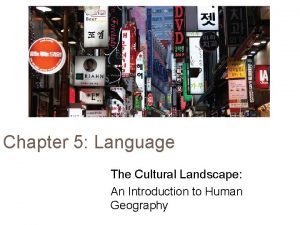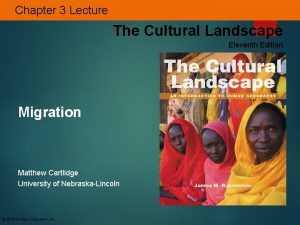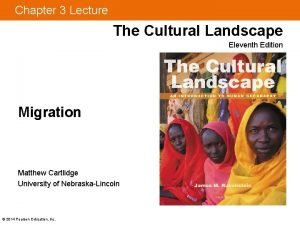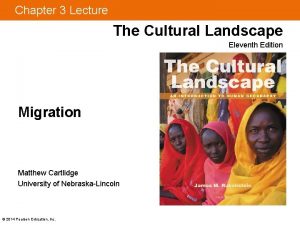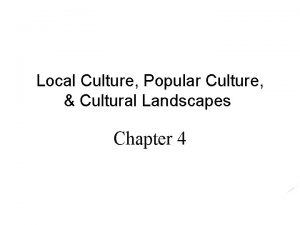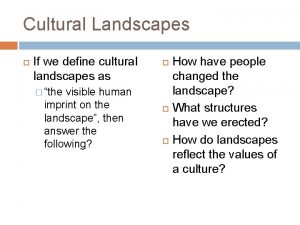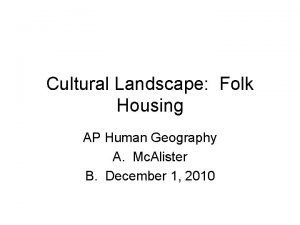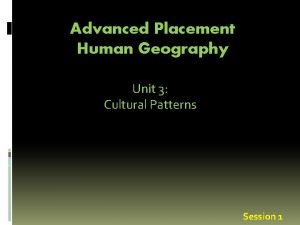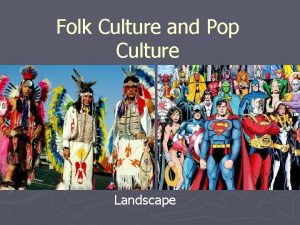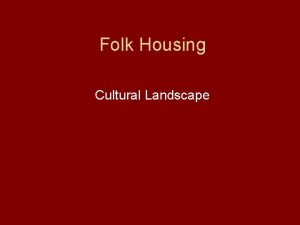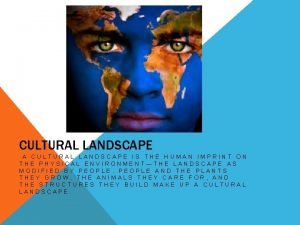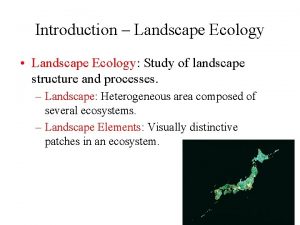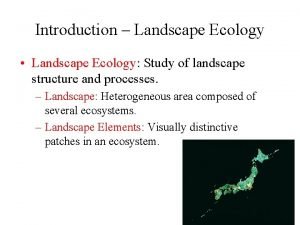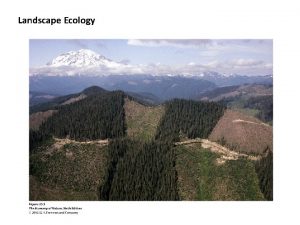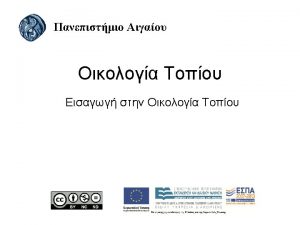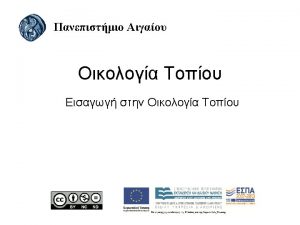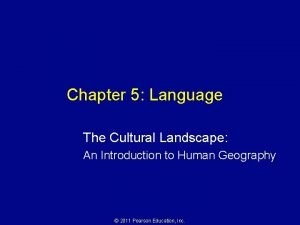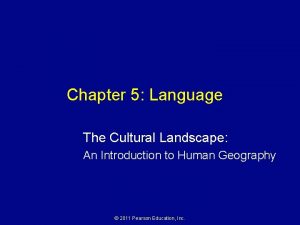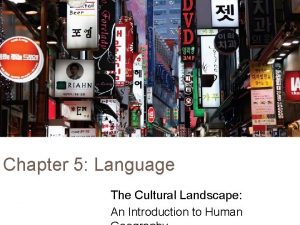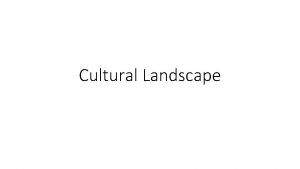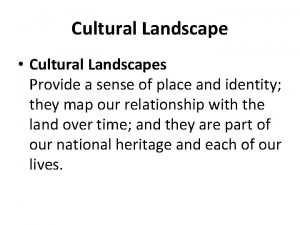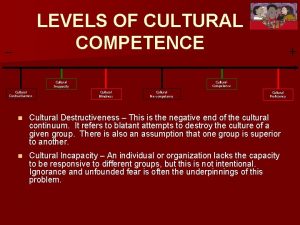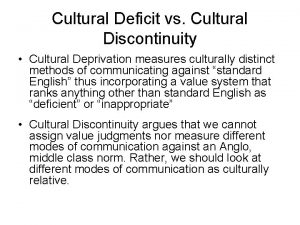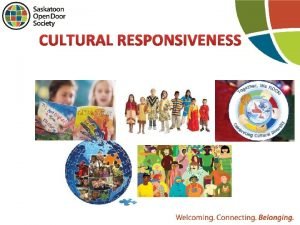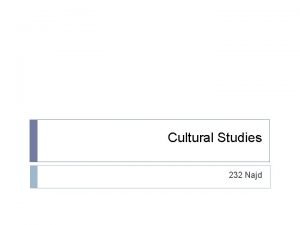Chapter 5 Language The Cultural Landscape An Introduction





































- Slides: 37

Chapter 5: Language The Cultural Landscape: An Introduction to Human Geography



Where Are English Language Speakers Distributed? Origin and diffusion of English is spoken by 380 million as a first language (1. 8 million as secondary) English colonies Origins of English German invasions Norman invasions

English-Speaking Countries Figure 5 -2

Invasions of England Figure 5 -3 http: //youtu. be/H 3 r 9 b. Ok. YW 9 s

© 2011 Pearson Education, Inc.

Where Are English Language Speakers Distributed? Dialects of English Isogloss = a word-usage boundary (“ya’ll” in the South) Dialects = a regional variation of a language In England Differences between British and American English

English Dialects Figure 5 -5

Where Are English Language Speakers Distributed? Dialects of English Dialects in the United States Settlement in the eastern United States Current differences in the eastern United States Pronunciation differences

Quick Think-Pair-Share You and your teammate(s) quickly write down every weird pronunciation or funny words you have heard or funny phrases spoken by people from a different state or area. © 2011 Pearson Education, Inc.

Dialects in the Eastern United States Figure 5 -7

Soft Drink Differences Figure 5 -8


Language Family Tree Figure 5 -17

Why Is English Related to Other Languages? Indo-European branches Language branch = collected of related languages Indo-European = eight branches Four branches have a large number of speakers: Germanic Indo-Iranian Balto-Slavic Romance

Branches of the Indo-European Family Figure 5 -9

Linguistic Differences in Europe and India Figure 5 -10 Figure 5 -11

Romance Branch Figure 5 -12


Why Is English Related to Other Languages? Origin and diffusion of Indo-European A “Proto-Indo-European” language? Internal evidence – similar root words: beech, oak, bear, deer, bee, etc. Nomadic warrior theory Sedentary farmer theory

Nomadic Warrior Theory - Marija Gimbutas The Kurgan!!!!!! hypothesis (also theory or model) is one of the proposals about early Indo. European language origins, which postulates that the people of an archaeological "Kurgan culture" (a term grouping the Yamna, or Pit Grave, culture and its predecessors) in the Pontic steppe (present day Kazakhstan – very nice!) were the most likely speakers of the Proto-Indo. European language. They were “nomadic” herders and migrated for greener grass… © 2011 Pearson Education, Inc. KURGAN!! !!!!!!!!!

Sedentary Farmer Theory - Colin Renfrow The Anatolian hypothesis is also called Renfrew's Neolithic Discontinuity Theory (NDT); it proposes that the dispersal (discontinuity) of Proto-Indo-Europeans originated in Neolithic Anatolia (present day Turkey – gobble, gobble). The hypothesis suggests that the speakers of the Proto-Indo-European language (PIE) lived in Anatolia during the Neolithic era, and associates the distribution of historical Indo-European languages with the expansion during the Neolithic revolution during the seventh and sixth millennia BC. It theorizes that the languages diffused as farmers migrated into Europe. © 2011 Pearson Education, Inc.

Where Are Other Language Families Distributed? Classification of languages Indo-European = the largest language family 46 percent of the world’s population speaks an Indo. European language Sino-Tibetan = the second-largest language family 21 percent of the world’s population speaks a Sino. Tibetan language Mandarin = the most used language in the world – From Where?

Language Families Figure 5 -16

Where Are Other Language Families Distributed? Languages of the Middle East and Central Asia Afro-Asiatic Arabic = most widely spoken Altaic Turkish = most widely spoken Uralic Estonian, Hungarian, and Finnish

Language Family Tree Figure 5 -17

Where Are Other Language Families Distributed? African language families Extensive 1, 000 linguistic diversity distinct languages + thousands of dialects Niger-Congo 95 percent of sub-Saharan Africans speak a Niger. Congo language Nilo-Saharan Khoisan “Click” languages

African Language Families Figure 5 -19

Nigeria’s Main Languages Figure 5 -20

Why Do People Preserve Languages? Preserving language diversity Extinct 473 languages “endangered” languages today Examples Reviving extinct languages: Hebrew Preserving endangered languages: Celtic Multilingual Walloons Isolated states and Flemings in Belgium languages Basque Icelandic

Languages in Belgium Figure 5 -23

Why Do People Preserve Languages? Global dominance of English: Lingua An example of a lingua franca = an international language Pidgin language = a simplified version of a language Expansion diffusion of English Ebonics

Why Do People Preserve Languages? Global dominance of English Diffusion to other languages Franglais The French Academy (1635) = the supreme arbiter of the French language Spanglish Denglish

English–French Language Boundary Figure 5 -27

American Accent Interactive Map © 2011 Pearson Education, Inc.

The End. Up next: Religion
 Nomadic warrior hypothesis
Nomadic warrior hypothesis The cultural landscape chapter 3
The cultural landscape chapter 3 The cultural landscape chapter 3
The cultural landscape chapter 3 The cultural landscape chapter 3
The cultural landscape chapter 3 Cultural landscape convergence
Cultural landscape convergence What is the meaning of cultural landscape
What is the meaning of cultural landscape Middle atlantic folk house
Middle atlantic folk house Migrant diffusion
Migrant diffusion Threats to folk culture
Threats to folk culture Hát kết hợp bộ gõ cơ thể
Hát kết hợp bộ gõ cơ thể Slidetodoc
Slidetodoc Bổ thể
Bổ thể Tỉ lệ cơ thể trẻ em
Tỉ lệ cơ thể trẻ em Chó sói
Chó sói Glasgow thang điểm
Glasgow thang điểm Chúa yêu trần thế
Chúa yêu trần thế Môn thể thao bắt đầu bằng chữ đua
Môn thể thao bắt đầu bằng chữ đua Thế nào là hệ số cao nhất
Thế nào là hệ số cao nhất Các châu lục và đại dương trên thế giới
Các châu lục và đại dương trên thế giới Công thức tính thế năng
Công thức tính thế năng Trời xanh đây là của chúng ta thể thơ
Trời xanh đây là của chúng ta thể thơ Cách giải mật thư tọa độ
Cách giải mật thư tọa độ Làm thế nào để 102-1=99
Làm thế nào để 102-1=99 Phản ứng thế ankan
Phản ứng thế ankan Các châu lục và đại dương trên thế giới
Các châu lục và đại dương trên thế giới Thể thơ truyền thống
Thể thơ truyền thống Quá trình desamine hóa có thể tạo ra
Quá trình desamine hóa có thể tạo ra Một số thể thơ truyền thống
Một số thể thơ truyền thống Cái miệng xinh xinh thế chỉ nói điều hay thôi
Cái miệng xinh xinh thế chỉ nói điều hay thôi Vẽ hình chiếu vuông góc của vật thể sau
Vẽ hình chiếu vuông góc của vật thể sau Nguyên nhân của sự mỏi cơ sinh 8
Nguyên nhân của sự mỏi cơ sinh 8 đặc điểm cơ thể của người tối cổ
đặc điểm cơ thể của người tối cổ Ví dụ giọng cùng tên
Ví dụ giọng cùng tên Vẽ hình chiếu đứng bằng cạnh của vật thể
Vẽ hình chiếu đứng bằng cạnh của vật thể Vẽ hình chiếu vuông góc của vật thể sau
Vẽ hình chiếu vuông góc của vật thể sau Thẻ vin
Thẻ vin đại từ thay thế
đại từ thay thế điện thế nghỉ
điện thế nghỉ
